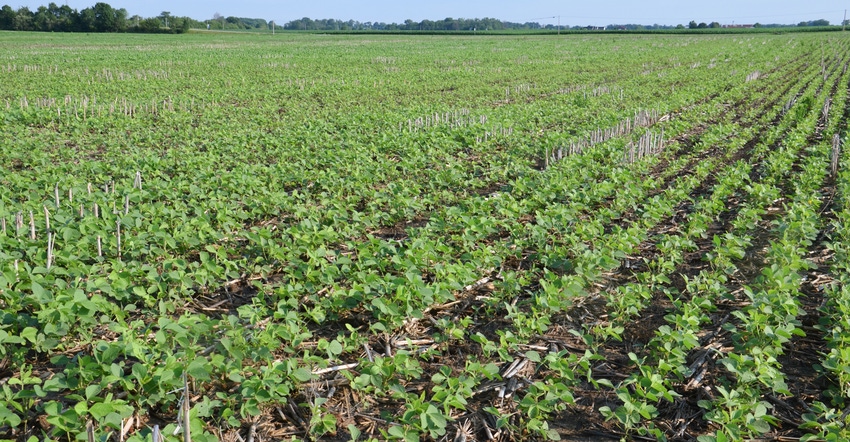
The 1973 growing season featured a wet spring in some areas. One farmer in central Indiana planted first-crop soybeans in 30-inch rows on July 15. They still yielded 33 bushels per acre, and that was with much older genetics and technology. Even though this year’s crop may be planted later than you like, there’s still time for it to produce good yields.
Steve Gauck, a Beck’s sales agronomist in Greensburg, Ind., says how you manage later-planted soybeans can impact final yield. Weather during the rest of the season will also play a huge role.
Gauck checks the Soybean Watch ’19 field and contributes to weekly online reports. Obviously, it will be a later-planted field this year. Beck’s sponsors Soybean Watch ’19.
Flowering impact
Managing later-planted soybeans begins with understanding how they’re impacted by the delay, Gauck says. “Soybeans begin flowering at or near the summer solstice, no matter the maturity or planting date,” he says. “We plant indeterminate soybeans, so they continue to grow even after flowering begins.
“The challenge with later-planted soybeans is getting more vegetative growth before they enter the reproductive stage. We want as many nodes as possible. That’s why we recommend increasing seeding rate to increase plant populations for plantings in late May and beyond. Higher seeding rates then encourage more growth through competition.”
Soybeans begin flowering around the first day of summer because they respond to night length, Gauck continues. Once flowering begins, it can continue over the next six to eight weeks. Before flowering, temperature drives vegetative growth. The warmer the summer, the faster plants develop, he says.
Planting delays may have delayed flowering past the summer solstice in some cases, Gauck says. Although photoperiod is a big driver of maturity, planting date and accumulation of growing degree days also play a role. On average, a three-week delay in planting may result in a one-week delay in maturity. Summer temperature patterns can push that one way or the other, Gauck observes. Even if flowering started later than normal, warmer temperatures may have helped speed up flowering and compensated for the late start.
Management matters
Here’s where management becomes critical for later-planted soybeans. “Soybeans have an almost unlimited potential to produce flowers, but most are aborted and never produce pods,” Gauck explains. “Anything you can do to eliminate or mitigate stress helps improve the number of flowers that will survive to produce pods. Keeping flowers and turning them into pods will increase yields.”
Later-planted beans may have fewer nodes per plant because they put more distance between nodes while playing catch-up on vegetative growth. Once flowering becomes heavy, plants slow vegetative growth and move energy to pod creation. Earlier-maturing soybeans will slow node production quicker than later-maturity beans, and move that energy to pods instead, Gauck says.
One of the biggest challenges later-planted soybeans often face during pod fill is more stress due to summer heat, Gauck says. “Doing whatever you can to keep plants healthy and green longer will be the key to high-yielding, late-planted soybeans,” he says. If anything, scouting will be more important this season, he stresses. The scouting calendar may be shifted back about a week, but you’re looking for the same pests and diseases.
“We also need not be afraid to use tools like fungicides and foliar fertilizer to keep plants healthy,” he concludes.
About the Author(s)
You May Also Like




